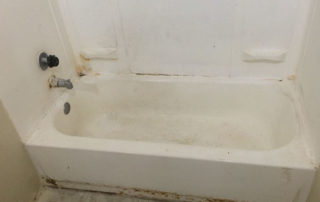5 Acrylic Shower Room Problems and Solutions
5 Acrylic Shower Room Problems and Solutions
Blog Article
{This Site Listed here below yow will discover some professional additional info concerning Hiring a Plumbing Company. We recommend that you clean your acrylic bathing product made of Delta ProCrylic or Acrylic with Innovex Technology with non-abrasive soaps and cleaners, such as: When it’s time to clean, always use a terry cloth towel, soft cloth or sponge to avoid scratching the acrylic surface. Don’t use abrasive scrubbing pads, steel wool or sponges, cause permanent damage to the acrylic material. If you use a drain cleaner or clog remover, be sure to rinse thoroughly with water so no product is left standing near the drain. Some chemicals and cleaners may deteriorate acrylic surfaces, causing cracks and, potentially, property damage. To avoid this, don’t use cleaning products that state on their label that they are not suitable for use on Acrylic, ABS, Polystyrene or Plastic. Be sure to check the label of any product before you apply it to the surface; it’s easier to avoid damage than to try to remedy it. Chemicals we do not recommend using to clean acrylic showers/tubs: When you’re ready to apply sealant, a little planning goes a long way. Pick up some painter’s tape and use it to mask off the seam to help make cleaning up easier. When you’re applying the bead, use a constant, steady speed to avoid an uneven finish. Use a caulk tool or a plastic spoon to work the sealant into the joint. Wetting the tool with denatured alcohol will help create a smooth finish. Follow the directions on the back of the tube for cure time. Certain chemicals and cleaners may deteriorate acrylic surfaces, causing cracks and, potentially, property damage. After you’re finished applying it, clean up the product surface and remove any excess sealant with denatured alcohol. Don’t use solvents (turpentine, lacquer thinner, mineral spirits, paint thinner, MEK, xylene, acetone, naphtha, etc.) that can wreak havoc on an acrylic surface. With a little care and consideration, you can prevent damage to your acrylic shower or tub. Keep a supply of soft cloths handy and remove any damaging products or abrasive scrubbing items from the bathroom to ensure they aren’t around when it’s time to clean. https://www.deltafaucet.com/design-innovation/inspiredliving/how-to-clean-acrylic-shower I discovered that page on Things To Look Out for Before Hiring a Plumbing Company when perusing the internet. Sharing is good. Helping others is fun. Many thanks for your time. Kindly check our blog back soon.
Polymer baths, shower trays, as well as various other acrylic shower room ware have become a lot more common in shower rooms in recent times. Thanks to modern-day chemistry we currently have options to enamel as well as ceramic products for washroom fixtures. These include different polers as well as plastic materials. Though not as classy and resilient as enamel and porcelain bathrooms and components, they are a lot more affordable and serve pretty much the same standard purpose. These materials are very easy to produce, shop, as well as transportation and also in the incidence of damages, they are easily repaired. Some usual instances of damages to acrylic washroom fixtures include staining, fractures, openings, and so on. Let's take a look at several of these problems and fast means of fixing them.Scraped shower or bathroom surface
Acrylic restroom fixtures are not abrasion-resistant like enamel ranges. Being a very soft material, acrylic scrapes can also be concealed without finish or filling. For these, you ought to look for specialist aid for your bath repairs.Chain reaction
In some cases, people attempt to paint the whole surface of their acrylic bathroom by themselves either due to the fact that they do not like the color to conceal imperfections. You must never use paint cleaner on acrylic bathrooms. Paint cleaners do not respond with the surface area of metal baths, they ruin acrylic bathrooms irreversibly.Bath Staining
With prolonged use of acrylic baths comes discoloration or staining. While some stains can be removed easily, making use of unique chemicals, others call for that the bath be resprayed. It is necessary to note that bleach or detergents do extremely little in getting rid of such discoloration and also they may also aggravate it. Many times, these cleansing representatives induce discoloration with time. Aromatherapy oils loosen the dirt in many cases thus bring back the bath to its former magnificence. Cleaning up and also polishing likewise occasionally. For more stubborn stains, you will need a new layer of finishing. This type of fixing will certainly need a specialist.Cracked Polymer Baths
The life-span of acrylic and fiberglass baths is up to 15-20 years for shower pans and baths, usually. Splits in an acrylic shower tray are probably among the most convenient issues to repair for a repair work specialist. The most effective component is you get to see the results nearly right away. This coincides for PVC, material, as well as various other such materials. A min split should be attended to on schedule prior to it spreads additional resulting in more severe damages. While these can be chosen a spending plan tackily, a professional can help you get it finished with even more finesse for a cost. Quick home fixes can be done with epoxy resins yet if the result turns out improperly, this would make the fixing a lot more tough for a professional.
Acrylic bathrooms, shower trays, as well as other acrylic shower room ware have become much more typical in bathrooms in current times. You need to never ever make use of paint eliminator on acrylic bathrooms. Paint cleaners do not respond with the surface of metal bathrooms, they destroy acrylic baths irreversibly. With prolonged use of acrylic bathrooms comes discoloration or discoloration. The life-span of acrylic and also fiberglass baths is up to 15-20 years for shower pans and bathrooms, normally.How to clean Acrylic shower
USE THESE NON-ABRASIVE CLEANERS
DO NOT USE THESE CLEANERS
Sealant Application Tips

Set Up An Appointment